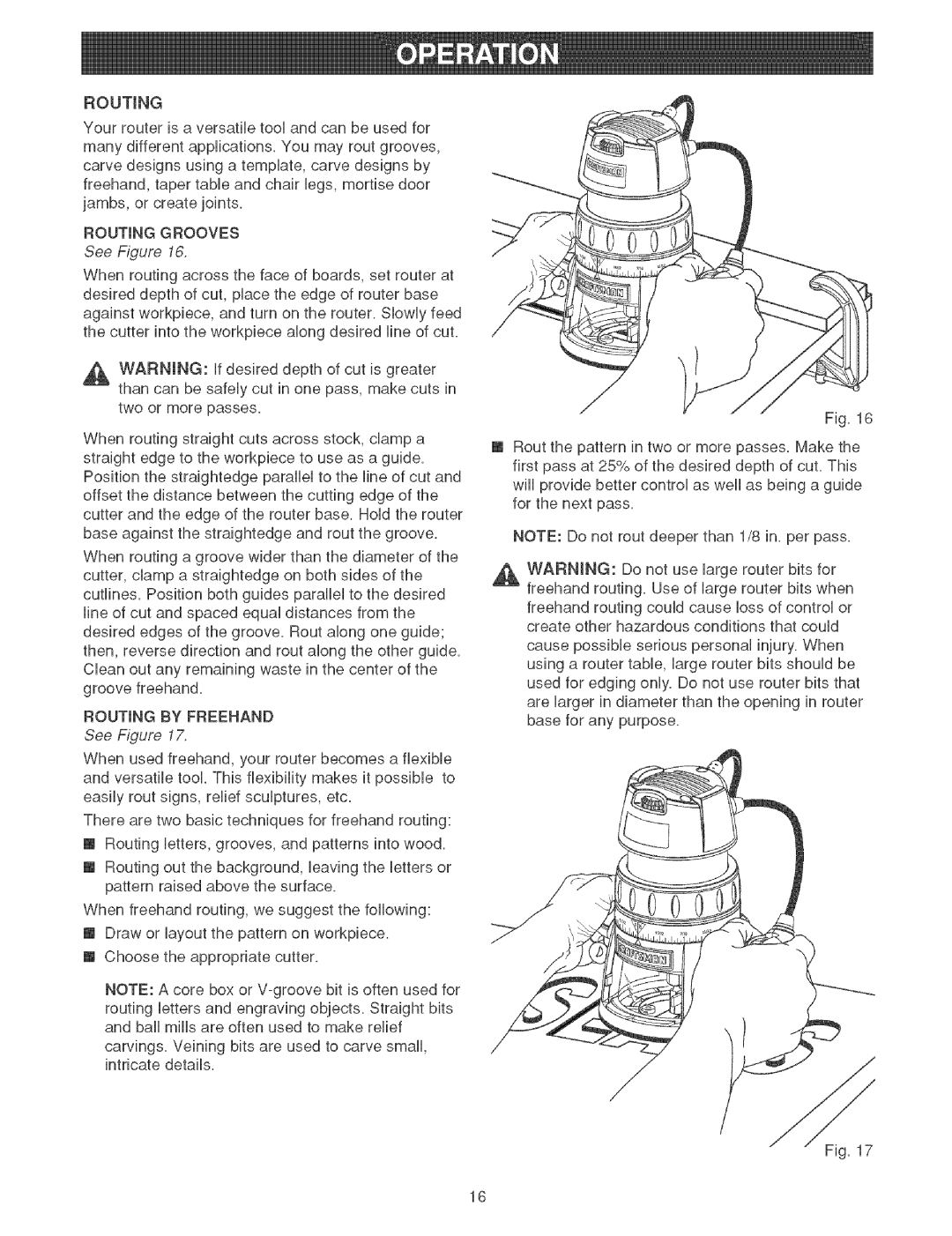
ROUTING
Yourrouterisa versatiletooUandcarlbeusedfor
marlydifferentappHcationsYoumayroutgrooves,. carvedesignsusinga tempUate,carvedesignsby freehand,tapertaNeandchairUegs,mortisedoor jambs,orcreatejoints.
ROUTINGGROOVES
See Figure 16.
When routing across the face of boards, set router at desired depth of cut, pUacethe edge of router base against workpiece, and turn on the router. SbwUy feed the cutter into the workpiece along desired Hne of cuL
,_ | WARNING: | If desired | depth of cut is greater |
|
|
| |
| than can be safeUycut in one pass, make cuts in |
|
|
| |||
| two or more | passes, |
|
|
| Fig, 16 | |
|
|
|
|
|
| ||
When routing straight cuts across stock, damp a | Rout the pattern in two or more passes, Make the | ||||||
straight edge to the workpiece to use as a guide, | |||||||
first pass at 25% of the desired depth of cut, This | |||||||
Position the straightedge parallel to the line of cut and | |||||||
will provide better control as well as being a guide | |||||||
offset the distance between the cutting edge of the | |||||||
for the next pass, |
| ||||||
cutter and the edge of the router base, Hold the router |
| ||||||
|
|
| |||||
base | against the straightedge | and rout the groove, | NOTE: Do not rout deeper than | 1/8 in, per pass, | |||
When routing a groove wider than the diameter of the |
|
|
| ||||
cutter, clamp a straightedge | on both sides of the | ,_ WARNING: | Do not use large | router bits for | |||
cutlines, Position both guides parallel to the desired | freehand routing. Use of large router bits when | ||||||
freehand routing could cause loss of control or | |||||||
line of cut and spaced equal distances from the | |||||||
create other hazardous conditions that could | |||||||
desired edges of the groove, Rout along one guide; | |||||||
cause possible serious personal injury. When | |||||||
then, reverse direction and rout along the other guide, | |||||||
using a router table, large router bits should be | |||||||
Clean out any remaining waste in the center of the | |||||||
used for edging only. Do not use router bits that | |||||||
|
|
|
| ||||
ROUTING BY FREEHAND |
| are larger in diameter than the opening in router | |||||
| base for any | purpose. |
| ||||
|
|
|
|
| |||
See F_Ture 17.
When used freehand, your router becomes a flexible and versatile tool. This flexibility makes it possible to easily rout signs, relief sculptures, etc.
There are two basic techniques for freehand routing: [] Routing letters, grooves, and patterns into woo&
[] Routing out the background, leaving the letters or pattern raised above the surface.
When freehand routing, we suggest the following: [] Draw or layout the pattern on workpiece.
[] Choose the appropriate cutter.
NOTE: A core box or
routing letters and engraving objects. Straight bits and ball mills are often used to make relief
carvings. Veining bits are used to carve small, intricate detail&
Fig, 17
16
